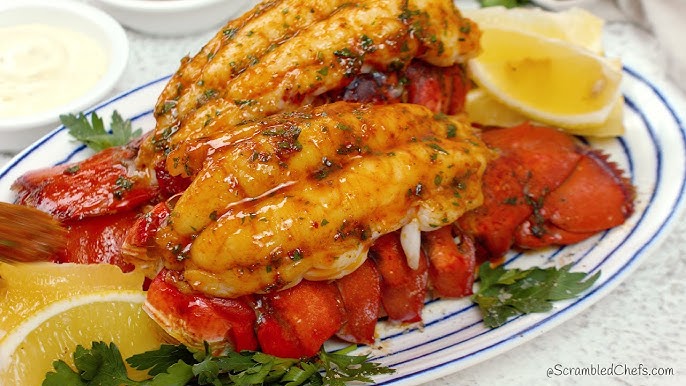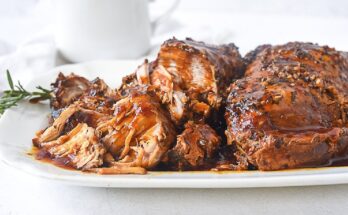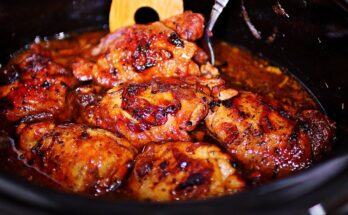Baked Lobster Tail Recipe: Lobster tails have long been considered the crown jewel of seafood dining. Whether you’re planning a romantic dinner for two, celebrating a special occasion, or simply indulging in a gourmet treat, baked lobster tails offer an elegant and flavorful experience. This recipe not only brings out the natural sweetness of lobster but also infuses it with rich buttery flavors and aromatic herbs.
Many people shy away from cooking lobster at home, fearing it’s too complicated or requires professional-level skills. The truth is, with the right guidance, anyone can bake lobster tails perfectly in their own kitchen. The secret lies in choosing quality lobster tails, preparing them with care, and baking them at just the right temperature.
In this article, you’ll get a step-by-step guide to making baked lobster tails, along with tips, variations, and serving ideas that will turn your dish into a restaurant-quality masterpiece. Let’s dive into the world of lobster cooking and learn how you can make this luxurious dish right at home.
Why Lobster Tails Are a Luxurious Dish
Lobster has always been associated with luxury and fine dining. Unlike other seafood, lobster has a naturally sweet, delicate taste that pairs perfectly with butter, garlic, and herbs. The tail portion is especially prized because it contains the most tender, meaty part of the lobster without requiring the hassle of cracking claws.
Serving baked lobster tails instantly elevates any meal. The presentation is stunning—the bright red shell contrasted with golden-baked meat makes it a showstopper on any dining table. For many, it represents more than just food; it’s a symbol of celebration, romance, and indulgence.
Cooking lobster tails at home not only saves you money compared to restaurant prices but also allows you to customize the flavors exactly to your liking. Whether you enjoy bold Cajun spices, classic garlic butter, or a zesty lemon twist, lobster tails can adapt beautifully to a variety of seasonings.
Perfect Occasions to Serve Baked Lobster Tail
Baked lobster tails are versatile enough to serve for different occasions:
- Romantic Dinners: A perfect choice for anniversaries, Valentine’s Day, or date nights.
- Family Gatherings: Impress your loved ones during holidays like Christmas, New Year’s Eve, or Easter.
- Dinner Parties: Hosting guests? Lobster tails create a “wow” factor that turns an ordinary dinner into a gourmet experience.
- Personal Indulgence: Sometimes, you don’t need a reason. Treat yourself to a special dinner—you deserve it.
In short, baked lobster tails aren’t just food; they’re an experience that creates memories and makes moments special.
Ingredients You’ll Need
Cooking lobster tails doesn’t require a long list of ingredients. In fact, the simpler the seasoning, the better you can taste the natural flavors of the lobster. Here’s what you’ll need for a basic baked lobster tail recipe:
Fresh Lobster Tails
The star of the show, of course, is lobster. You can buy either fresh or frozen lobster tails depending on availability. Frozen tails are more common and perfectly fine as long as they’re thawed properly before cooking. Choose tails that are about 5–6 ounces each for the ideal portion size.
Seasonings and Spices
To enhance the lobster’s natural sweetness, you’ll want a few key spices:
- Salt and pepper (basic seasoning)
- Paprika (adds color and mild smokiness)
- Garlic powder or minced fresh garlic for a savory kick
These simple seasonings are enough to highlight the lobster’s flavor without overpowering it.
Butter Mixture
Butter is what transforms lobster tails into a rich, decadent dish. You’ll need:
- Unsalted butter (melted)
- Lemon juice (for brightness)
- Fresh herbs like parsley or thyme
Mixing melted butter with lemon and herbs creates a mouthwatering sauce that you’ll brush over the lobster before baking.
Optional Garnishes
For extra flair, you can add:
- Fresh lemon wedges for serving
- Chopped parsley for color and freshness
- Parmesan cheese for a creamy twist
These finishing touches not only enhance flavor but also elevate the visual appeal of your dish.
How to Choose the Best Lobster Tails
Before you start cooking, it’s important to select the right lobster tails. The quality of your lobster will determine the overall taste and texture of your dish.
Fresh vs. Frozen Lobster Tails
- Fresh lobster tails are often sold at seafood markets but can be harder to find depending on where you live. They’re usually more expensive but offer the freshest flavor.
- Frozen lobster tails are widely available at supermarkets. They’re flash-frozen to preserve freshness and are perfectly suitable for baking when thawed correctly.
If you’re buying frozen, make sure there are no ice crystals or freezer burn, which could indicate improper storage.
Sizing and Quality Tips
When buying lobster tails, size matters.
- Small tails (4–6 ounces): Ideal for individual servings and faster cooking.
- Large tails (8–12 ounces): Great for a more filling meal but require slightly longer cooking times.
Look for tails with firm, translucent meat and a shell that’s not discolored. A fresh lobster tail should not smell overly “fishy.”
Where to Buy Lobster Tails
- Seafood markets are the best place for quality lobster tails.
- Grocery stores often carry frozen lobster in the seafood section.
- Online seafood retailers can deliver premium lobster tails straight to your door.
Wherever you buy, always prioritize quality. A good lobster tail will make all the difference in your baked recipe.
Preparing Lobster Tails Before Baking
Proper preparation is key to achieving that tender, flavorful baked lobster tail. Don’t skip these steps if you want restaurant-quality results.
Thawing Lobster Tails Properly
If you’re using frozen lobster, it’s crucial to thaw them the right way:
- Best Method: Place the lobster tails in the refrigerator overnight.
- Quick Method: Seal them in a plastic bag and submerge in cold water for 30–60 minutes.
Avoid microwaving or using hot water, as this can partially cook the meat and ruin the texture.
Cutting and Splitting the Shell
To make your lobster tails look elegant and ensure even cooking:
- Use kitchen scissors to cut through the top of the shell lengthwise.
- Gently pull the shell apart to expose the meat.
- Lift the meat slightly and rest it on top of the shell for a beautiful presentation.
This technique, known as “butterflying,” not only looks impressive but also allows the seasoning and butter to coat the meat evenly.
Cleaning and Seasoning
Once butterflied, rinse the lobster tails lightly under cold water to remove any grit. Pat dry with a paper towel. Then, season with salt, pepper, paprika, and garlic. Brush generously with melted butter and lemon juice.
At this point, your lobster tails are prepped and ready to hit the oven.
Step-by-Step Guide to Baking Lobster Tails
Now comes the exciting part—baking your lobster tails to perfection. This method is simple, quick, and yields tender, juicy meat every time.
Preheating the Oven
Start by preheating your oven to 375°F (190°C). This temperature is perfect for baking lobster without drying it out.
Applying the Butter and Seasoning
Place the prepared lobster tails on a baking sheet lined with foil or parchment paper. Brush each tail generously with the butter mixture, making sure the seasoning seeps into every crevice of the meat.
Baking Time and Temperature
Bake the lobster tails in the preheated oven for about 12–15 minutes, depending on size. A good rule of thumb is 1 minute of cooking per ounce of lobster.
Checking for Doneness
You’ll know your lobster is done when:
- The shell turns a bright red.
- The meat becomes opaque and white, not translucent.
- An internal temperature of 140°F (60°C) is reached.
Be careful not to overcook—the meat should be tender, not rubbery.
Once baked, drizzle with extra melted butter, garnish with fresh parsley, and serve with lemon wedges.
Flavor Variations for Baked Lobster Tails
One of the best things about lobster is how versatile it can be when it comes to flavoring. The natural sweetness of the meat pairs beautifully with a wide range of spices, herbs, and sauces. While the classic garlic butter is always a crowd-pleaser, you can easily elevate your baked lobster tails with creative twists that suit your personal taste. Let’s explore a few irresistible flavor variations.
Garlic Herb Butter
The most popular and timeless option, garlic herb butter, is a favorite for good reason. To make it, melt unsalted butter and mix it with freshly minced garlic, lemon juice, and chopped herbs like parsley, thyme, or dill. Brushing this mixture over the lobster before baking infuses it with a deep, aromatic flavor. Once baked, drizzle extra garlic butter on top for an indulgent finish. This version is perfect if you want something rich, savory, and classically elegant.
Spicy Cajun Style
For those who enjoy bold flavors and a little kick, Cajun-style lobster tails are an excellent choice. Combine melted butter with Cajun seasoning, paprika, cayenne pepper, and a hint of garlic powder. The spices coat the lobster meat, creating a smoky, slightly spicy profile that’s absolutely irresistible. This version pairs beautifully with roasted potatoes or grilled corn, giving your lobster dinner a Southern-inspired twist.
Lemon-Parsley Twist
If you prefer something lighter and fresher, the lemon-parsley variation is a refreshing option. Mix melted butter with lots of lemon zest, fresh lemon juice, and finely chopped parsley. This creates a bright, zesty flavor that balances the richness of lobster without overpowering it. It’s ideal for summer dinners or when you want a dish that feels light yet still indulgent.
The beauty of baked lobster tails lies in experimentation—you can start with the classic butter base and build your own flavor variations with spices, citrus, or even a sprinkle of cheese. The key is to complement the natural sweetness of lobster rather than mask it.
Side Dishes to Serve with Baked Lobster Tails
No lobster dinner is complete without the perfect side dishes. The right pairings can turn your meal into a feast, balancing flavors and textures while enhancing the luxurious taste of lobster. Here are some excellent sides to consider.
Classic Pairings like Mashed Potatoes
Creamy mashed potatoes are a traditional favorite to serve alongside lobster tails. The buttery, velvety texture of mashed potatoes complements the tender lobster meat beautifully. You can also elevate them with garlic, parmesan, or even truffle oil for a gourmet twist. Rice pilaf, baked potatoes, or buttered noodles are also great classic pairings that keep the focus on the lobster.
Fresh Salads and Vegetables
For a lighter, refreshing option, pair lobster with fresh greens or roasted vegetables. A simple arugula salad with lemon vinaigrette works wonderfully, cutting through the richness of lobster. Grilled asparagus, roasted Brussels sprouts, or sautéed green beans are also fantastic choices. These sides add color, crunch, and a healthy balance to your plate.
Wine Pairing Suggestions
Lobster tails pair exceptionally well with wine, and the right choice can enhance the dining experience. White wines like Chardonnay, Sauvignon Blanc, or Pinot Grigio are excellent because their crispness balances the richness of butter. If you prefer sparkling wines, a chilled glass of Champagne or Prosecco adds an elegant touch. For those who enjoy red wine, a light Pinot Noir is subtle enough not to overpower the delicate lobster flavor.
When paired thoughtfully, your side dishes and drinks will elevate baked lobster tails into a complete, restaurant-worthy meal that delights every bite.
Common Mistakes to Avoid
Even though baking lobster tails is relatively simple, a few common mistakes can ruin the dish. Knowing what to avoid will save you from disappointment and ensure your lobster turns out tender, juicy, and flavorful every time.
Overcooking Lobster Meat
The biggest mistake home cooks make is overcooking. Lobster meat cooks quickly, and just a few extra minutes can turn it rubbery and tough. Always follow the recommended cooking times and use a meat thermometer if possible. The ideal internal temperature is around 140°F (60°C). Remember, lobster continues cooking slightly after being removed from the oven, so it’s best to take it out just before it’s fully done.
Skipping Seasoning
Some people think lobster doesn’t need much seasoning since it’s naturally flavorful. While true, skipping seasoning altogether can result in bland lobster. Even a simple mix of butter, garlic, lemon, salt, and pepper makes a world of difference. Seasoning enhances the meat’s sweetness and gives it depth without overshadowing its natural taste.
Using Low-Quality Butter
Butter is one of the key ingredients in baked lobster tails, so don’t cut corners with quality. Low-quality butter can have an oily texture and lack flavor. Instead, opt for unsalted, high-quality butter. This ensures a creamy, rich taste that blends beautifully with herbs and garlic. For an extra indulgent experience, try using clarified butter (ghee), which has a more concentrated flavor and won’t burn easily in the oven.
By avoiding these mistakes, you’ll always end up with a perfectly baked lobster tail that impresses both you and your guests.
Tips for Serving Lobster Tails Like a Pro
Presentation matters just as much as taste when it comes to lobster tails. After all, part of the charm of this dish is its elegance. By serving lobster tails the right way, you can make a simple dinner feel like a fine dining experience.
Presentation Ideas
One of the most attractive ways to serve lobster is the “butterfly cut,” where the meat is lifted out of the shell and placed on top before baking. This not only helps with even cooking but also looks absolutely stunning when served. Garnishing with fresh parsley, lemon slices, or edible flowers adds color and visual appeal.
Keeping Lobster Warm Before Serving
Timing is everything when serving lobster. If your sides aren’t ready yet, you can keep baked lobster tails warm by covering them lightly with foil and placing them in the oven on the lowest heat setting. Avoid leaving them uncovered, as the meat can dry out quickly.
Plating with Style
For a restaurant-style presentation, serve each lobster tail on a large white plate with colorful sides like roasted vegetables or salad. Drizzle extra melted butter around the plate for a glossy finish, and place a lemon wedge on the side for squeezing. If you’re hosting guests, serve lobster tails with small ramekins of clarified butter for dipping—it feels luxurious and adds an interactive element to the meal.
With just a little effort, you can turn your lobster dinner into a memorable experience that feels straight out of a high-end restaurant.
Nutritional Value of Lobster Tails
Lobster isn’t just delicious; it’s also surprisingly nutritious. Many people assume lobster is unhealthy because it’s often paired with butter, but on its own, lobster meat is lean and packed with essential nutrients.
Protein and Vitamins
Lobster is an excellent source of lean protein, making it a fantastic choice for building and repairing muscles. It also contains important vitamins such as B12, which supports brain health and energy levels, and Vitamin E, an antioxidant that helps protect cells.
Low-Fat Benefits
Contrary to what some may think, lobster meat is relatively low in fat and calories. A 6-ounce lobster tail contains around 140 calories and less than 3 grams of fat. This makes it a healthier seafood option compared to richer cuts of red meat. The main source of fat comes from the butter often used in recipes—so if you’re watching calories, you can use less butter or replace it with olive oil for a lighter version.
Comparing Lobster to Other Seafood
When compared to shrimp, crab, or salmon, lobster stands out for its high protein-to-fat ratio. It’s lower in fat than salmon but richer in protein than shrimp. Lobster also provides essential minerals like zinc, magnesium, and selenium, which are important for immune health and overall well-being.
So, not only is lobster a treat for your taste buds, but it’s also a smart addition to a balanced diet when prepared thoughtfully.
FAQs about Baked Lobster Tail Recipe
Q1: Can I bake lobster tails without butter?
Yes, you can substitute butter with olive oil or coconut oil for a lighter option. Olive oil with garlic and lemon makes a healthier yet flavorful alternative.
Q2: Do I need to remove the vein from lobster tails before cooking?
Yes, much like shrimp, lobster tails sometimes have a dark vein running through the meat. While it’s not harmful, it can affect the texture and taste, so it’s best to remove it before baking.
Q3: What’s the best way to cut lobster tails for presentation?
The butterfly cut is the most popular method. Use kitchen scissors to cut along the top of the shell and pull the meat out slightly, resting it on top for a beautiful presentation.
Q4: Can I bake lobster tails with cheese?
Definitely! Adding a light sprinkle of parmesan or gruyere cheese on top before baking creates a rich, creamy crust that pairs wonderfully with lobster.
Q5: Should I marinate lobster tails before baking?
Lobster meat is delicate, so long marinades aren’t recommended. Instead, brush with butter, herbs, and spices right before baking for the best flavor.
Conclusion
The best part? Making baked lobster tails at home is easier than most people think. From choosing the right lobster tails to preparing, seasoning, and baking them to perfection, this guide has walked you through every step. Along the way, you’ve learned how to avoid common mistakes, explore creative flavor variations, pair your lobster with the best sides, and even serve it like a pro.
Now it’s your turn to roll up your sleeves and try it yourself. Whether you stick to the classic garlic butter version or experiment with Cajun spices or lemon-parsley freshness, you’ll discover that homemade lobster tails can be just as impressive—if not better—than what you’d order in a fancy restaurant.
So go ahead, preheat that oven, melt some butter, and get ready to wow yourself and your guests with the perfect baked lobster tail.



